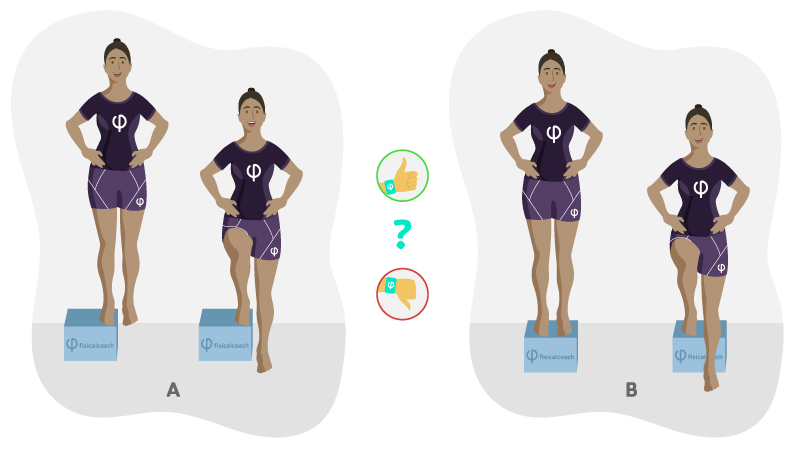
Lateral step down test
These tests are used to assess tibiofemoral rotation in the frontal and sagittal planes, as well as to analyse motor control at a global level.
- Required material: A 20 cm high step, step or box.
- Procedure: The test begins by asking the subject to climb the step and place his hands on his waist. From this position, he/she must try to keep the limb being assessed in support and the contralateral limb in support, and must descend the step by making a lateral support with the calcaneus (figure A), or a frontal support (figure B). Throughout the movement, the participant should try to keep the trunk, hip, knee and ankle aligned.
- Assessment: The deviation of the trunk, hip, knee and ankle from the reference line is assessed using a point system. Alterations in the control of the knee in the reference line (valgus or varus) are considered as signs of a possible risk of injury. Similarly, trunk leaning to one side, loss of pelvic line alignment, pronation of the foot, separation of the hands from the waist, oscillation or incorrect support of the limb descending the step are also considered to be alterations of movement control. The scoring system is as follows:
- 1 POINT: If you remove your hand from your waist.
- 1 POINT: Tilting of the trunk in any position.
- 1 POINT: Loss of the horizontal plane of the hips.
- 1 POINT: If at the level of the knee, the tibial tuberosity is directed to the second toe.
- 2 POINTS: If at the level of the knee, the tibial tuberosity is directed to the medial border of the foot.
- 1 POINT: If the subject stepped on the non-examined limb or if the foot moved from side to side due to lack of balance.
The scoring system shall be summative according to the number of movement disturbances observed:
-
- 0-1 POINT = Good control and quality of movement.
- 2-3 POINTS = Moderate quality and control of movement.
- ≥4 POINTS = Poor quality and control of movement.
- Remarks: Although it is a test used to assess knee valgus and varus control, we can also analyse alterations in motor control at a general level to keep the indicated body segments aligned.
Take this test and 139 more in our App